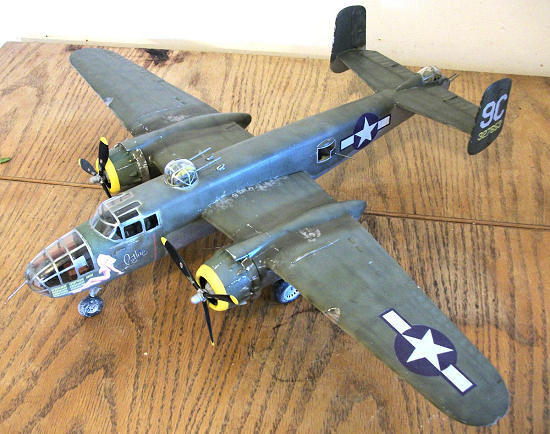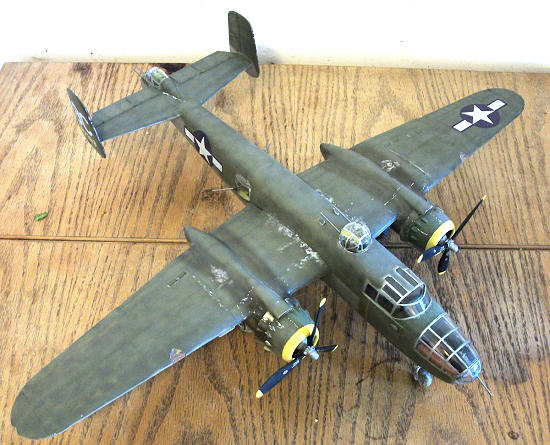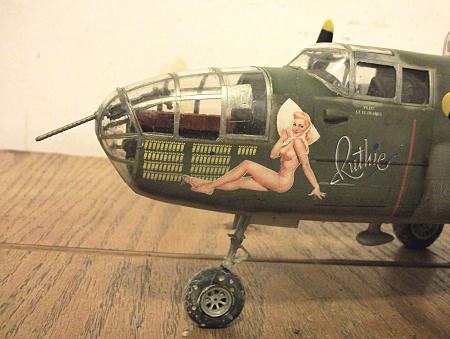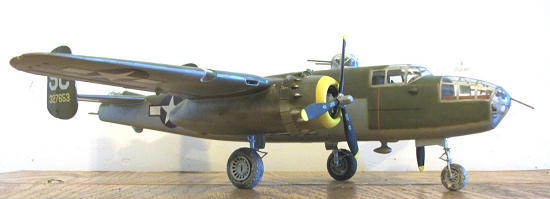Wingscale 1/32 B-25J Mitchell
|
KIT #: |
Test Shot |
|
PRICE: |
$ |
|
DECALS: |
None provided |
|
REVIEWER: |
Tom Cleaver |
|
NOTES: |
Used
upscaled Bombshell decals |

Yossarian: “Is Orr crazy?”
Doc Daneeka: “Of course he
is. He has to be crazy to keep flying after all the close calls he's had.”
Yossarian: “Why can't you
ground him?”
Doc Daneeka: “I can, but
first he has to ask me.”
Yossarian: “That's all he's
gotta do to be grounded?
Doc Daneeka: “That's all.”
Yossarian: “Then you can
ground him?”
 Doc Daneeka: “No. Then I
cannot ground him.”
Doc Daneeka: “No. Then I
cannot ground him.”
Yossarian: “Aah!”
Doc Daneeka: “There's a
catch.”
Yossarian: “A catch?”
Doc Daneeka: “Sure.
Catch‑22. Anyone who wants to get out of combat isn't really crazy, so I can't
ground him.”
Yossarian: “Ok, let me see
if I've got this straight. In order to be grounded, I've got to be crazy. And I
must be crazy to keep flying. But if I ask to be grounded, that means I'm not
crazy anymore, and I have to keep flying.”
Doc Daneeka: “You got it,
that's Catch‑22.”
Yossarian: “Whoo... That's
some catch, that Catch‑22.”
Doc Daneeka: “It's the best
there is.”
The B-25s based on
Corsica
have interested modelers more than any other B-25 unit except the 345th
“Air Apaches”, in large part due to a book written by a navigator of the 488th
Bomb Squadron of the 340th Bomb Group. “Catch 22" by Joseph Heller is
ranked as one of the greatest war novels ever written, and is Heller’s memorial
to the men who flew from the “USS Corsica” in 1944-45 during the air war over
northern Italy and southern France.
Here’s the real story:
The 340th Bomb
Group:
The 340th Bomb Group was activated on
August 20, 1942,
and trained on the B‑25 Mitchell medium bomber.
The 340th was the last bomb group to arrive in
North Africa,
showing up in March, 1943, and entering combat April in time to fly missions in
support of the British Eighth Army’s assault on the Mareth Line while assigned
to the 9th Air Force.
The first major campaign following the German surrender in North Africa the unit
took part in was the bombing of the islands of Pantelleria and Lampedusa in
May-June 1943, which led to the surrender of the islands without need of a
military invasion, the only time air forces ever accomplished such a thing.
That August, the 340th BG received a Distinguished Unit
Citation for operations during the period April-August 1943 in support of the
British Eighth Army in
Tunisia
and Allied forces in
Sicily.
Following the Sicilian campaign, the 340th was transferred to
the new 12th Air Force in August 1943.
The 12th Air Force would be the tactical air force for the
coming Italian campaign, while the new 15th Air Force would take over
the strategic bombing campaign of southeastern
Europe
and southern
Germany
in concert with the England-based 8th Air Force.
The 9th Air Force was transferred to
England
to become the tactical air force for the coming invasion.
 During the Italian campaign from September 1943 to March 1944, the 340th
bombed airfields, railroads, bridges, road junctions, supply depots, gun
emplacements, troop concentrations, marshaling yards and factories in Italy,
Bulgaria, Albania, Yugoslavia, and Greece while based at Pompeii Airfield near
Terzigno, Italy just a few kilometers from the foot of Mount Vesuvius and the
site of the ancient Roman town that had been destroyed in 79 AD.
During the Italian campaign from September 1943 to March 1944, the 340th
bombed airfields, railroads, bridges, road junctions, supply depots, gun
emplacements, troop concentrations, marshaling yards and factories in Italy,
Bulgaria, Albania, Yugoslavia, and Greece while based at Pompeii Airfield near
Terzigno, Italy just a few kilometers from the foot of Mount Vesuvius and the
site of the ancient Roman town that had been destroyed in 79 AD.
The last great eruption of
Mount Vesuvius
(to date) occurred on
March 18-23, 1944,
and rivaled that of 79 AD which saw the destruction of
Herculaneum
and
Pompeii.
The volcano did more damage to the USAAF in its
Foggia
complex of bases than the Germans managed to do in the entire Italian campaign.
The volcano destroyed 88 of the 340th Bomb Group’s aircraft.
The hot volcanic ash that covered nearly all of the Mitchells burned
fabric control surfaces, and glazed, melted, or cracked plexiglass.
Some B‑25s were tipped on their tails from the weight of the ash once it
entered the aircraft through wrecked canopies and turrets.
No lives were lost in this event, but the effects of the volcano turned
out to be insurmountable, despite a major effort to repair and salvage the
damaged aircraft.
As a result, the 340th Bomb Group was moved with the rest of
the fighter, bomber and reconnaissance units of the 57th Wing to the
island of Corsica, where they were far removed from any further peril from Mount
Vesuvius, and were also placed strategically to provide better support for the
Italian campaign as the lines moved through central Italy and on into the
northern half of the peninsula over the next year of the war, in addition to
positioning the aircraft to make raids on southern France and southern Austria.
So many Allied aircraft were based on
Corsica
that it became known as the “USS
Corsica”
for its position as a stationary aircraft carrier in the
Mediterranean.
Following the move to
Corsica
in April 1944, the 340th - which had been flying B-25C and B-25D
bombers since their arrival in the MTO - were completely re-equipped with new
B-25J bombers. To maximize bomb
loads and performance, the four-gun “strafer packs” were removed.
On the night of
May 13-14, 1944,
the Luftwaffe mounted a bombing raid on the Allied airfields on
Corsica.
The event is memorialized in the novel and movie “Catch-22" as the raid
where
Milo
Minderbinder “pays off” the Germans for his business dealings, and tells
Yossarian that anyone in the unit who is killed will have his share of the
profits from “MM Industries” sent to their family.
Following this raid, many of the 340th B-25s were hurriedly
camouflaged on their upper surfaces with what was likely British or Italian dark
green paint applied roughly to the silver upper surfaces of these
otherwise-unpainted aircraft, giving the unit a very distinctive look for the
remainder of the war as the survivo rs continued to make their missions.
rs continued to make their missions.
Flying from
Corsica,
the 340th participated in the invasion of southern
France
that August, and in attacks against lines of communication in
Northern Italy
from September 1944 to April 1945, during which period the unit effectively took
100 percent losses, which certainly demonstrates why there would be a “Catch-22"
to keep aircrew from quitting.
During this period, the 340th
specialized largely in close support and "bridge‑busting," repeatedly
hitting rail bridges, viaducts and tunnels, in the Italian
Alps
and
Apennine
Mountains
to create road blocks. During the
Battle of the Brenner Pass in March-April 1945, the goal was to cut off supplies
to the Germans in the Gothic Line in the Po Valley, which ultimately led to the
German surrender in northern Italy on April 25, 1945.
During the Brenner campaign, the 340th flew more missions than
any other medium bomb group.
On
September 23, 1944,
the 340th sank the Italian cruiser “Taranto”
in the
harbor
of
La Spezia
before the Germans could sink the ship and block the harbor entrance, winning
their second DUC for this mission.
The 340th Bomb Group flew its last bombing mission on
April 26, 1945,
slightly more than 25 months after it first went into action in
Tunisia.
While the 340th was one of the last medium bomb groups to
enter combat in the Mediterranean Theater, over the course of 898 missions it
set the highest "bomb tonnage dropped" mark for medium bomber units in the MTO
by the end of the war and additionally maintained the best bombing accuracy
record in the MTO during the last year of the war.
It was about this time a year ago that Wingscale, a company founded by
the owner of Dutch Decals, announced a very ambitious production program of 1/32
multi-engine bomber models, starting with the B-25H and J, with the J to be
released in both the bomber and strafer version, with these kits followed up by
the Holy Grail of Holy Grails, a 1/32 B-17G.
Sadly, the company came to an end in March 2011 in a contract dispute
between the originator and his Chinese production partners.
Only four test shot kits of the B-25J ever made it out, one to a modeler
in the
Netherlands,
one to Brett Green at HyperScale, one to a reviewer at Large Scale Planes, and
this one to yours truly at Modeling Madness.
The original plan was to have them quickly built so that reviews could go
up when the kits were released, which was supposed to have been in April 2011.
When the failure w as announced, my enthusiasm for speedily finishing the
kit waned. So far as I know, the
only other of these test shots that was built was the one sent to the
Netherlands.
Had I not already started the kit when that announcement was made, it
would have been quite valuable to a collector.
I remember receiving a four-figure offer for it, unassembled.
as announced, my enthusiasm for speedily finishing the
kit waned. So far as I know, the
only other of these test shots that was built was the one sent to the
Netherlands.
Had I not already started the kit when that announcement was made, it
would have been quite valuable to a collector.
I remember receiving a four-figure offer for it, unassembled.
Wingscale may be still a company, and may still release the B-25J and the
B-17G, but in the meantime WingXL has been organized by the same guy, to release
similar kits, starting with a B-25C/D, followed by a B-17F, with further
announcements of a B-26 Marauder, A-26 Invader, A-20 Havoc, P-61 Black Widow,
deHavilland Mosquito, and Bristol Beaufighter.
At present these announced kits are all “vaporware.”
If these announced kits are done to the same level of quality that this
B-25J is, they will be beautiful kits indeed.
This kit has the finest, most petite surface detail I have seen on any
kit other than the Tamiya P-51D and the Tamiya Spitfires.
Yes, the rivets on a B-25 are really of the raised variety, other than
the leading one-third of the wings, but this engraved detail is so fine and
petite that it really looks very close to old “Photo Fanny” out at
Chino.
Essentially, the kit looks a lot like a scaled-up Monogram kit, with many
more small details, particularly in the cockpit and bombardier’s nose.
This is a good thing, since the Monogram kit was well-designed and has
now stood the test of time.
 The instructions were not organized as they likely would be, though they
were well designed. It would have
been very helpful in assembling the model if the part numbers had been on the
various sprues, since all the parts were referred to by number in the draft of
the instructions. Thus, assembly
frequently devolved into a guessing game, holding the illustration and
attempting to match the drawing to a part. At various points, I also failed to
find either instructions or parts for various sub-assemblies.
This is most noticeable in the upper turret, where the upper section of
the internal structure was not present.
While this is not so much a “how-to” review, since no one can say if the
kit will ever be released and if so if it will be released as designed here, I
am going over the test shot as I built it to point out areas a modeler will have
to be concerned with should they ever build such a kit.
The instructions were not organized as they likely would be, though they
were well designed. It would have
been very helpful in assembling the model if the part numbers had been on the
various sprues, since all the parts were referred to by number in the draft of
the instructions. Thus, assembly
frequently devolved into a guessing game, holding the illustration and
attempting to match the drawing to a part. At various points, I also failed to
find either instructions or parts for various sub-assemblies.
This is most noticeable in the upper turret, where the upper section of
the internal structure was not present.
While this is not so much a “how-to” review, since no one can say if the
kit will ever be released and if so if it will be released as designed here, I
am going over the test shot as I built it to point out areas a modeler will have
to be concerned with should they ever build such a kit.
Besides the upper turret, which I pieced together so it looks all right
from a distance of a few feet, the other big problem area was the engine
cowlings. These are multi-part
affairs, with an underlying structure.
The way that structure is designed and molded, when you cut away the
extra sprue inside it, you need to use clippers, because if you attempt to cut
these thick sprues away with a knife, you will run the risk of breaking the part
as you apply the necessary pressure, which leads to it not keeping its shape and
strength after being repaired. I
managed to do that to one, and learned from that to use clippers on the other.
With the one I did right, it was easy to attach the separate cowling
panels and get them to align properly, and to get the cowling front piece
attached correctly. The other one
fought all the way, with the result of glue smears and the panels not as closely
and smoothly attached as they should have been.
Since this model is going directly to
Chino
where it will be displayed in a glass case, the incorrectly-done cowling
immediately became the right hand cowling, since the left side of the model will
face out to the viewer.
All B-25 models have problems with getting enough weight in them to make
sure they nose sit. Terry Dean
worked with me to create an up-sized version of his 1/48 B-25 nose weight.
Fortunately, it took two tries to get it the right size, though it will
really need a third attempt to enlarge it to get it heavy enough to fill out
that who side of the nose. As it
turned out, I needed to use
 both weights, with the one weight replacing the
bombardier’s tunnel under the cockpit; since this isn’t a contest model, that
won’t be noticed from three feet away in a glass case.
If any 1/32 B-25 kit or kits ever become available, you will need to get
the Terry Dean weights. I was
thankful the kit was designed with either plastic or metal landing gear legs.
With the weight of this model to get it to nose-sit, I used the metal
gear.
both weights, with the one weight replacing the
bombardier’s tunnel under the cockpit; since this isn’t a contest model, that
won’t be noticed from three feet away in a glass case.
If any 1/32 B-25 kit or kits ever become available, you will need to get
the Terry Dean weights. I was
thankful the kit was designed with either plastic or metal landing gear legs.
With the weight of this model to get it to nose-sit, I used the metal
gear.
Overall, the fit of parts is excellent, other than getting the bombardier
nose onto the fuselage and the engine cowlings over the engines and then those
whole assemblies attached to the engine nacelles.
I think a further refinement of the molds from the experience of the test
shot would have gotten the nose attachment better.
I only had to use putty along that joint, which I then rescribed and
recreated the rivet detail with my pounce wheel.
I used Tamiya surfacer along the fuselage centerline seam, which also
required some rescribing and “re-riveting” once it was cleaned up.
Everything else fits very tightly and precisely.
After I masked off the cockpit canopy and the bombardier canopy, I
painted the fabric covered control surfaces with
 Tamiya Flat Aluminum and then
masked that off. I painted the
lower surfaces and fuselage sides with Talon acrylic Aluminum/ The upper
surfaces were painted with Tamiya “RAF Dark Green,” which was post-shaded to
show sun-fading.
Tamiya Flat Aluminum and then
masked that off. I painted the
lower surfaces and fuselage sides with Talon acrylic Aluminum/ The upper
surfaces were painted with Tamiya “RAF Dark Green,” which was post-shaded to
show sun-fading.
Since the kit didn’t come with decals, I asked my friend John Lester to
make me a set of 1/32 decals from the excellent Bombshell Decals 1/48 sheet for
the 340th Bomb Group B-25s, to do “Rosie.”
These ALPS decals went on easily under a coat of Micro-Sol.
I was glad to have a white backing for the figure of “Rosie,” since the
decals were opaque enough, but not solidly so; this way I was able to get the
nude down in a the best way.
I first “dinged” the upper wings in the vicinity of the gas filler caps
with Tamiya flat Aluminum. I then
applied several coats of Xtracrylix Flat varnish to the upper surfaces.
When that was dry, I unmasked the canopies.
I attached the guns to the waist windows and glued those in position,
then glued the tail guns into position.
I attached the wheels and the props.
 This is an impressively-large model, so big in fact that I was very glad
to be able to take it directly out to Planes of Fame for display, since the only
place I had with a shelf wide enough for it was an upper shelf in a closet.
If this kit is released as originally planned, it will provide the basis
for a really good, highly-detailed model that won’t take much beyond patience
and skill to turn into a show-stopper.
Since the designer of this kit is also the designer for the WingsXL
company, if those kits ever appear it’s likely they will be of similar quality.
Had this model appeared as planned, it would have been a very serious
contender with the Tamiya 1/32 P-51D for the appellation of “Kit of the Year.”
This is an impressively-large model, so big in fact that I was very glad
to be able to take it directly out to Planes of Fame for display, since the only
place I had with a shelf wide enough for it was an upper shelf in a closet.
If this kit is released as originally planned, it will provide the basis
for a really good, highly-detailed model that won’t take much beyond patience
and skill to turn into a show-stopper.
Since the designer of this kit is also the designer for the WingsXL
company, if those kits ever appear it’s likely they will be of similar quality.
Had this model appeared as planned, it would have been a very serious
contender with the Tamiya 1/32 P-51D for the appellation of “Kit of the Year.”
Tom Cleaver
January 2012
If you would like your product reviewed fairly and fairly quickly, please contact the editor or see other details in the
Note to
Contributors.
Back to the Main Page
Back to the Review
Index Page


 Doc Daneeka: “No. Then I
cannot ground him.”
Doc Daneeka: “No. Then I
cannot ground him.” During the Italian campaign from September 1943 to March 1944, the 340th
bombed airfields, railroads, bridges, road junctions, supply depots, gun
emplacements, troop concentrations, marshaling yards and factories in Italy,
Bulgaria, Albania, Yugoslavia, and Greece while based at Pompeii Airfield near
Terzigno, Italy just a few kilometers from the foot of Mount Vesuvius and the
site of the ancient Roman town that had been destroyed in 79 AD.
During the Italian campaign from September 1943 to March 1944, the 340th
bombed airfields, railroads, bridges, road junctions, supply depots, gun
emplacements, troop concentrations, marshaling yards and factories in Italy,
Bulgaria, Albania, Yugoslavia, and Greece while based at Pompeii Airfield near
Terzigno, Italy just a few kilometers from the foot of Mount Vesuvius and the
site of the ancient Roman town that had been destroyed in 79 AD.  rs continued to make their missions.
rs continued to make their missions.  as announced, my enthusiasm for speedily finishing the
kit waned. So far as I know, the
only other of these test shots that was built was the one sent to the
as announced, my enthusiasm for speedily finishing the
kit waned. So far as I know, the
only other of these test shots that was built was the one sent to the

 both weights, with the one weight replacing the
bombardier’s tunnel under the cockpit; since this isn’t a contest model, that
won’t be noticed from three feet away in a glass case.
If any 1/32 B-25 kit or kits ever become available, you will need to get
the Terry Dean weights. I was
thankful the kit was designed with either plastic or metal landing gear legs.
With the weight of this model to get it to nose-sit, I used the metal
gear.
both weights, with the one weight replacing the
bombardier’s tunnel under the cockpit; since this isn’t a contest model, that
won’t be noticed from three feet away in a glass case.
If any 1/32 B-25 kit or kits ever become available, you will need to get
the Terry Dean weights. I was
thankful the kit was designed with either plastic or metal landing gear legs.
With the weight of this model to get it to nose-sit, I used the metal
gear. Tamiya Flat Aluminum and then
masked that off. I painted the
lower surfaces and fuselage sides with Talon acrylic Aluminum/ The upper
surfaces were painted with Tamiya “RAF Dark Green,” which was post-shaded to
show sun-fading.
Tamiya Flat Aluminum and then
masked that off. I painted the
lower surfaces and fuselage sides with Talon acrylic Aluminum/ The upper
surfaces were painted with Tamiya “RAF Dark Green,” which was post-shaded to
show sun-fading.